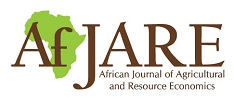
Supports Open Access
0.5 Impact Factor



African Journal of Agricultural and Resource Economics (AfJARE)
A publication of the African Association of Agricultural Economists (AAAE)
Latest Publications
Cet article analyse les effets des produits forestiers non ligneux (PFNL) sur la pauvreté multidimensionnelle au Burkina Faso. Il s'appuie sur des données primaires collectées auprès de 384 ménages sélectionnés aléatoirement.
Spatial variability in agricultural yield responses to climate change:Implications for index insurance in Burkina Faso
Index-based insurance has emerged as a compelling strategy for agricultural risk management in Africa, particularly in contexts where smallholder farmers are disproportionately exposed to climate-related hazards.
The current study investigated the impact of using information and communication technology-based weather information services on the adoption of climate change adaptation strategies.
Estimating profit, input demand and output supply elasticities in rice production: Evidence from Vietnam
Understanding rice farmers’ responses to market prices is essential for policy makers to design effective policies to better manage input demand and rice supply. This paper applies duality theory to derive the elasticities of input demand and output supply for Vietnamese rice production using a translog profit function approach.
This paper examines the optimal land resource allocation for tree crop enterprises in the Eastern region of Ghana based on data collected from sampled cocoa, oil palm, and rubber farmers.
Potato (Solanum tuberosum L.) is known for its efficiency in converting resources into high-quality food, which can aid in poverty reduction. However, the potato yield in Rwanda has been declining, leading to farmer dissatisfaction with trading terms and a reliance on low prices in the value chain.
Volume 20
The hazards and impacts of climate change are exacerbating. They threaten crop productivity, farmers’ resilience and the mitigation of greenhouse gas (GHG) emissions. Understanding climate-smart agriculture (CSA) and applying it is crucial.
Rural areas across the developing countries in every region of the world lag behind their urban counterparts in many important sectors and, most importantly, in improved water supply services.
Volume 19
Understanding rice farmers’ responses to market prices is essential for policy makers to design effective policies to better manage input demand and rice supply. This paper applies duality theory to derive the elasticities of input demand and output supply for Vietnamese rice production using a translog profit function approach.
Willingness-to-pay (WTP) studies for traditional food products are plausibly affected by unobserved decisions and strategic collusion between the experimenter and respondents. Similarly, WTP estimates in developing countries using a one-time survey might be inconsistent, as the acceptance of new products likely varies with exposure to product attributes.
This paper examines the optimal land resource allocation for tree crop enterprises in the Eastern region of Ghana based on data collected from sampled cocoa, oil palm, and rubber farmers.
Volume 18 (2023)
Evaluating the impact of agricultural practices helps policymakers and farmers in their decision-making. In Zambia, most households depend on agricultural activities, in particular maize production.
Uganda’s climate is changing in terms of rising temperatures and altered precipitation patterns, leading to extreme meteorological conditions such as prolonged drought, floods and landslides. Yet the majority (68%) of Ugandans rely largely on rain-fed agriculture, which is affected by climate variability.
Our understanding of climate-induced crop failure and crop abandonment is limited at present. This study surveyed theoretical and empirical literature on climate-induced crop failure and crop abandonment.

